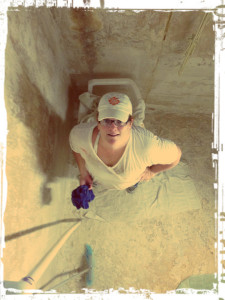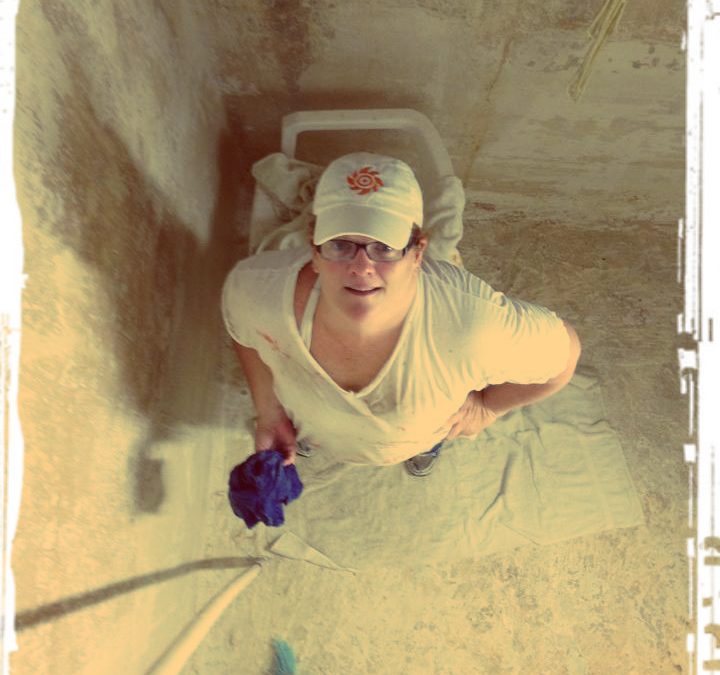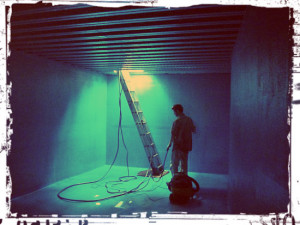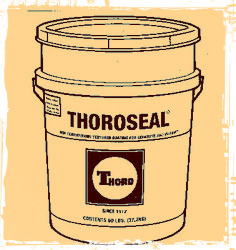I was raised on St. Croix and have spent most of my life here. I have survived not one, but two major hurricanes that have severely damaged my house. Out of necessity, I was forced to learn a lot about home repair. Well… necessity coupled with the fact that my father strongly believed in child labor! Add to that the decision made by my husband and I a few years back to renovate said home, I have become a Jack of All Trades, Master of None when it comes to home repair.
Over the years I have helped re-build two roofs, have laid countless ceramic tiles, have re-hung cabinet doors, have put up and finished drywall, and have painted seemingly endless miles of walls. The most recent addition to my resume? I have now also helped fix and re-seal a cistern.
For the benefit of those of you who are city dwellers, here in the islands the majority of us rely on cisterns for our water supply. Essentially, a cistern is a basement full of water that collects rain from the roof and is generally accessed by a 2 1/2 x 3 1/2 ft hole in the floor. We count on Mother Nature to provide us with enough rain to keep our cisterns full and because Mother Nature is not always consistently abundant with her gifts of precipitation, we treat water like liquid gold. What do we do should we run out of water, you ask? We begrudgingly call one of the local water companies and pay good money for a “load” of water.
Several months ago, we noticed that we were ordering water a bit more frequently than our fellow drought stricken neighbors. I decided to investigate and sought out some specifics from my parents. It was my father who ever so casually mentioned that he has no recollection of doing cistern maintenance since right around Hurricane Marilyn (that is how islanders measure time – we associate everything with a storm). Since Hurricane Marilyn, huh? That would mean the last cistern care was done… OH, GEE…18 years ago!
My poor husband. God love him, he is a patient man – he has to be to put up with my family, myself included. I don’t think he had any clue what he was getting himself into the day he met me, or the day he thought it would be a good idea to renovate this house. But, he took the cistern news in stride, as he does with most things I (or my parents, even) throw at him and resigned himself to the fact that now was our time to do cistern maintenance.
With good intentions, we set a date, gathered supplies, and formulated a plan to fix/re-seal the cistern – actually, more accurately, cisterns (yep, there is more than one).
THE PLAN went something like this…
- Day 1 – Pressure wash and pump out the front cistern; set-up “water diversion system”.
- Day 2 – “Thoroseal” the cistern and let dry.
- Day 3 – Continue to let dry.
- Day 4 – Apply second coat.
- Day 5 – Let second coat dry.
- Day 6 – Fill and repeat process for back cistern.
But because we live in the islands where Murphy’s Law rules, THE REALITY went a bit more like this…
- Day 1 – Pressure wash the cistern and attempt multiple strategies to remove frogs, excess water from pressure washing, and 18 years of sediment.
- Day 2 – Brainstorm and attempt new strategies to remove frogs, water from pressure washing, and 18 years of sediment.
- Day 3 – Perfect frog removal technique and release our 3-day frog collection back into the wild (far from our house) because my husband is a kind soul that does not believe in killing them.
- Day 3, Part 2, Nighttime – Curse the heavens for the rain that is now being collected in the cistern because our “water diversion system” has failed!
- Day 4 – Resign to the fact that we do not have the heart to waste ALL of the beautiful water that was collected overnight. Instead, plan to lavish in long showers in an attempt to speed-up the re-emptying of the cistern. Rejoice – this means I can shave my legs more than once this week!
Four months later… yes, FOUR months (thanks to the nonstop rain we had), we finally run out of water in the back cistern again. The front one has just enough to pressure-wash with, so we decide to move on with the project. It should be noted that this is no small undertaking; this means that a house of four people will potentially be out of water for at least six days. In preparation, we fill EVERY container we have with what little water we have left (after all, we still need to be able to flush toilets and wash our hands) and contact generous neighbors who are kind enough to open their home to us to take showers for the week. We’re now committed to getting the job done once and for all!
The good news is that the front cistern is still clean from four months ago, AND we are now pros at removing the excess water from pressure washing, as well as the 18 years of sediment (no frogs this time). We are able to complete this step with the precision and speed of a NASCAR pit crew. Moving on, it’s time to re-seal a cistern!
Because we are optimists, THE PLAN went something like this…
- Collect and assemble necessary supplies and lower through 2 ½ x 3 ½ ft hole in the floor.
- Move said supplies through front cistern to the back cistern and over the ½ ft wall that separates the two.
- Secure and triple check “water diversion system in back cistern”.
- Apply Thoroseal ever so neatly to prepped walls.
- Let dry and repeat for 2nd coat.
- Let dry, fill back cistern, and repeat process with the front cistern.
And again, because we are in the islands, THE REALITY went a little more like this…
- Discover that we were sold the wrong sealing product and trek to two hardware stores to rectify the problem.
- Collect and assemble necessary supplies and lower through 2 ½ x 3 ½ ft hole in the floor.
- Drag said supplies through front cistern to back cistern and try not to fall off of the ½ ft wall that separates the two as we move the supplies from one side to the other.
- Secure and quadruple check “water diversion system” in back cistern.
- Apply Thoroseal (which is more of a clay-like substance rather than an easily paintable paint-like substance – joy!) to the prepped walls while trying not to grate off our knuckles and/or slide and break ours neck on all the Thoroseal that has collected at our feet rather than on the walls, all this within the 45 minute time limit suggested by the directions. (What happens after 45 minutes? I have no clue, but I did know that with all that has happened with this project thus far, I was NOT about to find out!)
- Reappear from the cistern feeling triumphant, trying not to track Thoroseal through the house on your way outside to hose off so you do not risk ruining the newly tiled floors your husband has worked so hard to finish.
- Curse the heavens for the rain that is now being collected in the front cistern and pray with every ounce of energy you have left that the “water diversion system” holds. Wait with bated breath to see if we end up getting enough rain for the front to overflow to the back.…
- Days later, wade through 3 feet of chilly rain water to complete the 2nd coat … in your underwear.

I enjoyed a brief moment of pride and accomplishment when the back cistern was done, though it was unfortunately drowned out and quickly replaced with dread once I remembered that we still have to seal the the front (much larger) cistern.
Cistern adventure, anyone? Volunteers?



















7 Comments